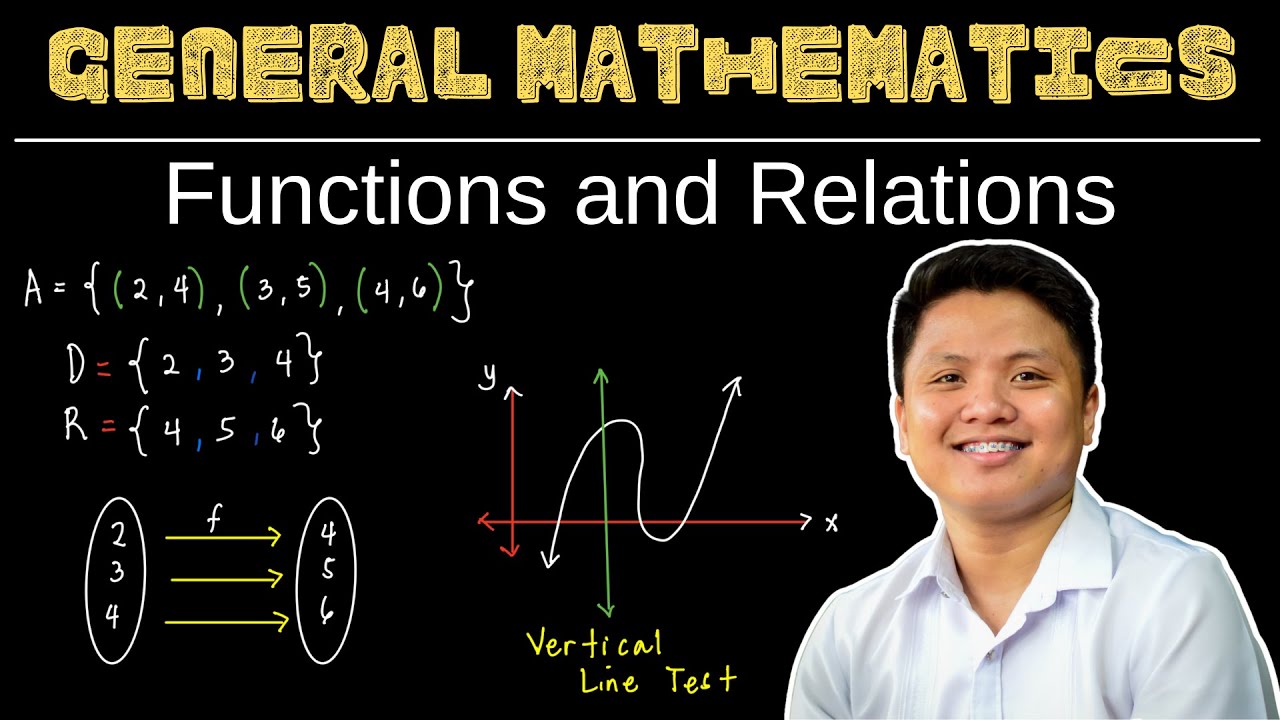Understanding Relations I Señor Pablo TV
Summary
TLDRThis educational video script introduces the concept of relations in mathematics, focusing on the representation of ordered pairs. It outlines four distinct methods to depict relations: table of values, mapping or arrow diagram, graph, and rule. The script explains each method with examples, starting with the table of values, where x and y coordinates are listed, followed by the mapping diagram that uses arrows to show the relationship between domains and ranges. The graph method plots these points in a coordinate system, and the rule method identifies a pattern, such as the sum of coordinates being constant. The script is designed to help viewers understand and visualize mathematical relations effectively.
Takeaways
- 📚 A relation is defined as a set of ordered pairs, with each pair consisting of an x-coordinate (abscissa) and a y-coordinate (ordinate).
- 📊 There are four primary ways to represent relations: table of values, mapping or arrow diagram, graph, and rule.
- 📈 The table of values is a tabular representation where the x-coordinates (abscissa) are listed horizontally and the y-coordinates (ordinate) are listed vertically.
- 🔍 The mapping or arrow diagram visually shows the relationship between x and y coordinates using arrows to connect corresponding values.
- 📊 The graph representation plots the ordered pairs on a coordinate system, allowing for a visual understanding of the relation as a whole.
- ✏️ The rule representation is a mathematical formula or condition that defines the relationship between the x and y coordinates, such as a sum or product.
- 🔢 For the given example, the rule is that the sum of the x-coordinate and y-coordinate equals six, illustrating a specific type of linear relation.
- 📐 The graph of the relation is a visual tool that can help identify patterns or characteristics of the relation, such as whether it is a linear function.
- 📝 Understanding different representations of relations is crucial for various mathematical applications, including functions and data analysis.
- 🎓 The video serves as an educational resource, teaching viewers how to interpret and work with relations in multiple formats.
Q & A
What is a relation in mathematics?
-A relation in mathematics is a set of ordered pairs, where each pair consists of an x-coordinate (abscissa) and a y-coordinate (ordinate).
How many ways can a relation be represented?
-A relation can be represented in four different ways: as a table of values, a mapping or arrow diagram, a graph, and by a rule.
What is the term for the first number in an ordered pair?
-The first number in an ordered pair is called the abscissa or x-coordinate.
What is the term for the second number in an ordered pair?
-The second number in an ordered pair is called the ordinate or y-coordinate.
How is a table of values created for a relation?
-A table of values is created by listing the x-coordinates (abscissa) in one column and the corresponding y-coordinates (ordinate) in another column.
What is a mapping or arrow diagram?
-A mapping or arrow diagram is a visual representation of a relation where each x-coordinate is connected to its corresponding y-coordinate with an arrow.
What is the term for the left side of a mapping diagram?
-The left side of a mapping diagram is known as the domain, which represents the set of x-coordinates.
What is the term for the right side of a mapping diagram?
-The right side of a mapping diagram is known as the range, which represents the set of y-coordinates.
How are points plotted on a graph to represent a relation?
-Points are plotted on a graph by marking the x-coordinate on the horizontal axis and the corresponding y-coordinate on the vertical axis.
What is a rule in the context of representing a relation?
-A rule is a mathematical statement or condition that defines the relationship between the x-coordinate and y-coordinate in a set of ordered pairs.
Can you provide an example of a rule from the script?
-Yes, an example of a rule from the script is that if you add the x-coordinate (abscissa) and y-coordinate (ordinate), the sum equals six.
Outlines

Cette section est réservée aux utilisateurs payants. Améliorez votre compte pour accéder à cette section.
Améliorer maintenantMindmap

Cette section est réservée aux utilisateurs payants. Améliorez votre compte pour accéder à cette section.
Améliorer maintenantKeywords

Cette section est réservée aux utilisateurs payants. Améliorez votre compte pour accéder à cette section.
Améliorer maintenantHighlights

Cette section est réservée aux utilisateurs payants. Améliorez votre compte pour accéder à cette section.
Améliorer maintenantTranscripts

Cette section est réservée aux utilisateurs payants. Améliorez votre compte pour accéder à cette section.
Améliorer maintenantVoir Plus de Vidéos Connexes

Relasi dan Fungsi | Matematika SMP

1 PENGERTIAN RELASI - RELASI DAN FUNGSI - KELAS 8 SMP

LOMBA VIDEO INOVASI PEMBELAJARAN / BEST PRACTICE / INOBEL / VIDEO PRAKTIK BAIK

THE LANGUAGE OF RELATIONS AND FUNCTIONS || MATHEMATICS IN THE MODERN WORLD

Relations and Functions | General Mathematics | Grade 11

RÁPIDO e FÁCIL | PLANO CARTESIANO | PRODUTO CARTESIANO
5.0 / 5 (0 votes)
